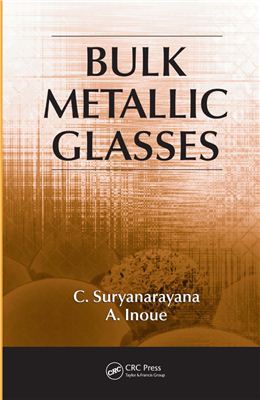CRC Press, 2011. 523 pp.
Metallic glasses with amorphous structures, first discovered in 1960, have both scientific and technological interest. The successful synthesis of bulk metallic glasses during the late 1980s has stimulated great enthusiasm in the study of this class of metallic materials. Substantial progress has been made in the understanding of physical, chemical, and mechanical properties of bulk metallic
glasses since the beginning of the 1990s. Characterization on the atomic scale indicates the formation of tightly bonded atomic clusters and loosely bonded free-volume zones in the amorphous state. Various polyhedral packings have been observed in these clusters, which are also confirmed by atomic simulations. Contrary to crystalline materials with periodic lattice structures, the plastic deformation of bulk metallic glasses proceeds via localized shear bands, resulting in inhomogeneous deformation at ambient temperatures. Bulk metallic glasses show extremely high strength, close to the theoretical strength of solids in the glassy state, and superplastic behavior in the supercooled liquid state.
At present, bulk metallic glasses are emerging as a new class of metallic materials with unique physical and mechanical properties for structural and functional use. This book is suitable for young researchers in materials science and applied physics, who are interested in leaing about bulk metallic glasses and are looking for a guidebook to launch research into this exciting materials field. Also, this book can be perfectly used as a textbook for graduate students.
Metallic glasses with amorphous structures, first discovered in 1960, have both scientific and technological interest. The successful synthesis of bulk metallic glasses during the late 1980s has stimulated great enthusiasm in the study of this class of metallic materials. Substantial progress has been made in the understanding of physical, chemical, and mechanical properties of bulk metallic
glasses since the beginning of the 1990s. Characterization on the atomic scale indicates the formation of tightly bonded atomic clusters and loosely bonded free-volume zones in the amorphous state. Various polyhedral packings have been observed in these clusters, which are also confirmed by atomic simulations. Contrary to crystalline materials with periodic lattice structures, the plastic deformation of bulk metallic glasses proceeds via localized shear bands, resulting in inhomogeneous deformation at ambient temperatures. Bulk metallic glasses show extremely high strength, close to the theoretical strength of solids in the glassy state, and superplastic behavior in the supercooled liquid state.
At present, bulk metallic glasses are emerging as a new class of metallic materials with unique physical and mechanical properties for structural and functional use. This book is suitable for young researchers in materials science and applied physics, who are interested in leaing about bulk metallic glasses and are looking for a guidebook to launch research into this exciting materials field. Also, this book can be perfectly used as a textbook for graduate students.

